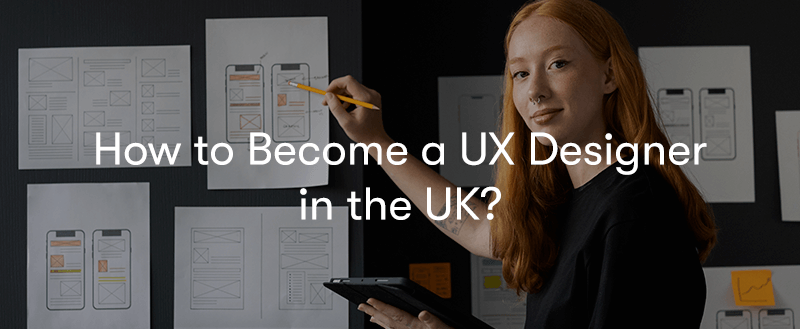How to Become a UX Designer?
Are you intrigued by the art of creating seamless, user-friendly digital experiences? Do you have a knack for problem-solving and a passion for design? If so, a career as a User Experience (UX) designer might be your perfect fit. In this blog, we will dive into the world of UX design, covering everything you need to know to embark on this exciting journey, from the essential skills to the intricacies of the job itself and the rewarding career opportunities that await you.
How to Become a UX Designer in the UK?

Becoming a UX designer in the UK involves a combination of education, skills development, networking, and building a strong portfolio. Here's a step-by-step guide on how to pursue a career as a UX designer in the UK:
Education and Skill Development
Educational Background: While a formal degree is not always required, having a bachelor's or master's degree in a related field like graphic design, human-computer interaction, or psychology can be beneficial. Some universities in the UK offer specific UX design programs.
Online Courses and Workshops: Many online platforms offer UX design courses. We offer a three day UX Foundation course.
Build Essential Skills
User Research: Learn how to conduct user interviews, surveys, and usability testing to understand user needs and preferences.
Interaction Design: Understand how to create intuitive and user-friendly interfaces by learning about wireframing, prototyping, and user flow design.
Visual Design: Develop skills in creating visually appealing designs, including colour theory, typography, and layout.
Usability Testing: Learn how to analyse user behaviour and feedback to refine and improve your designs.
Problem Solving: UX designers need to be able to identify problems and come up with innovative solutions to improve user experiences.
Create a Portfolio
Develop a strong portfolio showcasing your projects, including case studies that highlight your design process, problem-solving skills, and the impact of your designs on user experiences.
Include a variety of projects that demonstrate your expertise in different aspects of UX design, such as user research, wireframing, prototyping, and usability testing.
Networking
Attend UX design events, workshops, and conferences in the UK to meet professionals in the industry and stay updated on the latest trends and best practices.
Join online UX design communities, forums, and social media groups to connect with other designers, share knowledge, and learn from their experiences.
Job Search and Application
Look for UX design job openings on job boards, company websites, and professional networking platforms like LinkedIn.
Tailor your resume and cover letter to showcase your skills, relevant experience, and passion for UX design.
Be prepared for interviews that include discussing your portfolio, answering design-related questions, and demonstrating your problem-solving abilities.
Internships and Entry-Level Positions
Consider applying for internships or entry-level positions to gain practical experience and refine your skills.
These opportunities can help you build a professional network and gain insights into the industry.
Continuous Learning
UX design is a rapidly evolving field, so stay updated on the latest design trends, tools, and technologies.
Continue taking courses, attending workshops, and reading design blogs to enhance your skills.
Remember that the path to becoming a UX designer is unique for each individual. Persistence, a willingness to learn, and a passion for improving user experiences will significantly contribute to your success in the field.
Do You Need a Degree to Work as a UX Designer in the UK?
In short, No, you do not necessarily need a degree to work as a UX designer in the UK or in many other countries. While having a degree in a related field such as UX design, graphic design, human-computer interaction, or psychology can be advantageous, the UX design field strongly emphasises skills, experience, and portfolio.
Many successful UX designers have entered the field through self-learning, online courses, workshops, and building a strong portfolio of projects demonstrating their skills and abilities. However, remember that some companies might have specific educational requirements for their job postings.
What matters most is your ability to showcase your skills, creativity, problem-solving abilities, and understanding of user-centred design principles through your portfolio and practical experiences. Building a solid portfolio with real-world projects and demonstrating your proficiency in user research, interaction design, and usability testing can often be more important to potential employers than having a degree.
Ultimately, while a degree can provide a structured learning path and theoretical foundation, it is not the sole determinant of success in the UX design field. It's essential to continuously learn, refine your skills, and keep up with industry trends and best practices to excel as a UX designer.
What Skills Do You Need to Work as a UX Designer in the UK?

To work as a UX designer in the UK, you need a combination of technical skills, soft skills, and a solid understanding of user-centred design principles. Here are the essential skills you'll need to succeed in the field:
User-Centred Design
- Understanding user needs, behaviours, and motivations.
- Creating designs that prioritise user satisfaction and engagement.
- Developing empathy for users and their experiences.
User Research
- Conducting user interviews, surveys, and usability testing.
- Analysing and synthesising research findings to inform design decisions.
- Creating personas and user journey maps to guide the design process.
Interaction Design
- Designing intuitive and user-friendly interfaces.
- Creating wireframes, prototypes, and mock-ups to visualise user flows.
- Incorporating effective navigation, interactions, and feedback mechanisms.
Visual Design
- Applying principles of typography, colour theory, and layout design.
- Creating visually appealing graphics and icons.
- Ensuring consistency and brand alignment in design elements.
Usability Testing
- Planning and conducting usability tests to identify design flaws.
- Analysing user feedback and making iterative design improvements.
- Ensuring that designs meet usability and accessibility standards.
Information Architecture
- Organising content and information in a clear and structured manner.
- Creating sitemaps and user flows to guide the user's journey.
Prototyping and Tools
- Using prototyping tools (e.g., Figma, Sketch, Adobe XD) to create interactive designs.
- Proficiency in design and collaboration software.
Problem-Solving
- Identifying design challenges and proposing innovative solutions.
- Adapting designs based on user feedback and changing project requirements.
Collaboration
- Effectively communicating with cross-functional teams, including developers and stakeholders.
- Incorporating feedback from team members to refine designs.
Time Management
- Managing multiple projects and deadlines effectively.
- Prioritising tasks and delivering high-quality designs on time.
Communication Skills
- Presenting and explaining design concepts to both technical and non-technical audiences.
- Advocating for user-centred design principles within the organisation.
Industry Knowledge
- Staying updated on the latest UX design trends, technologies, and best practices.
Soft Skills
- Creativity: Generating unique design solutions.
- Empathy: Understanding user needs and emotions.
- Attention to Detail: Ensuring design precision and consistency.
- Open-Mindedness: Being receptive to feedback and new ideas.
While having a degree in a related field can be beneficial, creating a strong portfolio showcasing your skills and practical experience is crucial for demonstrating your capabilities to potential employers.
Can You Do an Apprenticeship in UX Design?

Yes, you can pursue an apprenticeship in UX design. Apprenticeships are a structured way to gain practical skills and experience in a professional setting. They provide a combination of on-the-job training and classroom-based learning, allowing you to develop your skills and knowledge in a real-world context.
Apprenticeships in the UK are regulated by the government and typically involve working with an employer while receiving training and education. They are available in various industries, including design, and offer a pathway to gaining recognised qualifications and certifications. To pursue an apprenticeship in UX design, you can follow these steps:
1. Research
Look for companies, agencies, or organisations that offer UX design apprenticeships. Check their websites, job boards, and apprenticeship directories for suitable opportunities.
2. Application
Apply for UX design apprenticeships that match your skills and interests. The application process may involve submitting a resume, portfolio, and possibly undergoing interviews.
3. Selection
If your application is successful, you'll be invited for interviews or assessments to determine your suitability for the apprenticeship role.
4. Apprenticeship Agreement
Once selected, you and the employer will sign an apprenticeship agreement outlining the terms, conditions, and expectations of the apprenticeship.
5. On-the-Job Training
You'll start working with the employer and participating in various UX design projects. You'll receive hands-on experience in areas like user research, prototyping, interaction design, and usability testing.
6. Classroom Learning
Depending on the apprenticeship program, you might attend classes, workshops, or training sessions related to UX design. These sessions are designed to complement your practical experience with theoretical knowledge.
7. Assessments
You might have assessments throughout the apprenticeship to gauge your progress and understanding of the material. These assessments contribute to your overall qualification.
8. Completion
Upon completing the apprenticeship, you'll receive a recognised qualification or certification, such as a Level 3 or Level 4 Diploma in UX Design.
Apprenticeships offer a valuable pathway for individuals who want to enter the UX design field while gaining practical experience and formal qualifications. They also provide a way to earn a salary while learning and can be an excellent option for those who prefer hands-on learning over traditional classroom education.
Remember that the availability of UX design apprenticeships may vary, and it's important to thoroughly research and apply to reputable programs that align with your career goals.
What Sort of Work Do UX Designers Do?

UX designers are responsible for creating and enhancing users' overall experience when interacting with a product or service. Their work ensures the user's journey is seamless, intuitive, and enjoyable. Here are some of the key tasks and responsibilities that UX designers typically perform:
User Research
- Conducting user interviews, surveys, and usability tests to understand user needs and preferences.
- Analysing user behaviours and identifying pain points or areas for improvement.
Personas and User Journey Mapping
- Creating personas that represent different user types and their characteristics.
- Developing user journey maps to visualise the steps users take to achieve their goals.
Information Architecture
- Organising content and information in a structured and user-friendly manner.
- Designing clear navigation paths ensures users can easily find what they're looking for.
Wireframing and Prototyping
- Designing low-fidelity wireframes to outline the basic layout and structure of a product.
- Creating interactive prototypes allows users to interact with the design and provide feedback.
Interaction Design
- Designing intuitive and user-friendly interfaces that guide users through tasks.
- Defining interactive elements, such as buttons, forms, and navigation menus.
Visual Design
- Applying principles of colour theory, typography, and visual hierarchy to create appealing designs.
- Designing graphics, icons, and other visual elements that enhance the user interface.
Usability Testing
- Planning and conducting usability tests to evaluate the effectiveness of designs.
- Collecting user feedback and identifying areas for improvement.
Iterative Design
- Incorporating feedback from users and stakeholders to make iterative design improvements.
- Refining and adapting designs based on user testing results.
Collaboration
- Collaborating with cross-functional teams, including developers, product managers, and marketers.
- Ensuring alignment between design goals and overall business objectives.
Accessibility and Inclusivity
- Ensuring that designs are accessible to users with disabilities and diverse backgrounds.
- Following best practices to create inclusive user experiences.
Data-Driven Design
- Analysing data and metrics to inform design decisions and improvements.
- Using data to identify trends, user behaviours, and areas for optimisation.
Staying Current
- Keeping up with the latest design trends, technologies, and industry best practices.
- Continuously learning and refining skills to stay competitive in the field.
The work of a UX designer is highly dynamic and involves a mix of creativity, problem-solving, empathy, and technical skills. UX designers contribute to creating products and experiences that prioritise user satisfaction, engagement, and effectiveness.
Is UX Design a Good Career?

Yes, UX design can be a rewarding and fulfilling career choice for many individuals. It offers a combination of creative expression, problem-solving, and the opportunity to directly impact how users interact with products and services. Here are some reasons why UX design can be a good career:
High Demand
As technology continues to evolve and user experiences become a critical differentiator for products and services, the demand for skilled UX designers is rising. Many companies recognise the value of user-centred design in achieving business goals.
Varied Opportunities
UX design spans various industries, including tech, finance, healthcare, e-commerce, and more. This diversity allows you to work on projects that align with your interests and passions.
Creativity
UX designers have the opportunity to be creative while solving real-world problems. Designing intuitive interfaces, crafting user journeys, and finding innovative solutions can be intellectually stimulating.
User Impact
UX designers directly impact the way users interact with technology. Creating positive user experiences can lead to increased user satisfaction, loyalty, and overall success of products.
Collaboration
UX design involves working with multidisciplinary teams, including developers, product managers, marketers, and more. Collaboration enhances your understanding of different perspectives and contributes to a holistic product vision.
Continuous Learning
The field of UX design is ever-evolving, which means you'll always have opportunities to learn and grow. New tools, techniques, and design trends emerge regularly, keeping the work dynamic and exciting.
Problem-Solving
UX designers tackle complex challenges by identifying user needs, understanding pain points, and devising solutions. Problem-solving skills are highly valued in this field.
Competitive Salaries
UX designers often command competitive salaries due to the specialised nature of their work and the high demand for their skills.
Flexibility
Many UX designers have the flexibility to work remotely, freelance, or choose from a range of employment options, providing a work-life balance that suits their preferences.
Job Satisfaction
Creating seamless and enjoyable experiences for users can be deeply satisfying. Knowing that your work directly impacts how people interact with technology can be personally rewarding.
However, it's important to note that, like any career, UX design also comes with challenges. Keeping up with rapidly evolving technology, managing design critiques, and balancing user needs and business goals can be demanding. Success in UX design often requires a strong commitment to continuous learning and adaptation.
Ultimately, whether UX design is a good career choice for you depends on your interests, strengths, and career goals. If you have a passion for problem-solving, creativity, and enhancing user experiences, a career in UX design could be an excellent fit.
What Salary Can You Expect as UX Designer in the UK?

The average salary for a UX designer in the UK is £66,000 a year. This can very vastly depending on location, experience and position. This can range anywhere from £30,000 for a junior UX designer to £100,000 for a senior UX designer. As with most professions, major cities such as London yield the highest salary for location.
Can You Find Work Doing UX Design Without Any Experience?
In short, yes, it is possible to find work in UX design without any prior professional experience, but it may require some extra effort and a strategic approach. Here are some steps you can take to secure a UX design job without prior experience:
Build a Strong Portfolio
- Create your own UX design projects, even if they are hypothetical or personal.
- Showcase your skills by including wireframes, prototypes, and design concepts in your portfolio.
- Emphasise your thought process, problem-solving abilities, and user-centred design principles in your project descriptions.
Participate in Internships or Volunteer Projects
- Look for unpaid or low-paid internships or volunteer opportunities in UX design.
- These opportunities can provide hands-on experience, mentorship, and networking opportunities.
Online Courses and Self-Learning
- Take online courses or workshops to learn UX design fundamentals and tools.
- Practice your skills by working on design challenges and personal projects.
Networking
- Attend UX design meetups, conferences, and networking events.
- Connect with professionals in the field through LinkedIn and other social platforms.
- Seek informational interviews to learn from experienced UX designers and gain insights into the industry.
Apply for Entry-Level Positions
- Look for entry-level UX design positions, such as UX design assistant or junior UX designer roles.
- Tailor your resume and cover letter to highlight your skills, portfolio, and passion for UX design.
Freelance Work
- Consider freelancing or gig work to gain practical experience.
- Freelance projects can help you build a portfolio and establish a track record of completed projects.
Continuous Learning and Improvement
- Stay up to date with the latest UX design trends, tools, and best practices.
- Seek feedback on your work and continuously improve your skills.
Transferable Skills
- Highlight any transferable skills from your previous experiences or education that could be relevant to UX design, such as problem-solving, communication, or attention to detail.
Show Enthusiasm and Passion
- During interviews and in your application materials, convey your enthusiasm for UX design and your commitment to learning and growing in the field.
It's important to recognise that breaking into the field without experience may require patience and persistence. Be open to opportunities that allow you to gain practical skills and gradually work your way up in the UX design profession. Building a strong portfolio and network, along with a willingness to learn and adapt, can help you secure your first job in UX design.
Where Can You Learn More About UX Design?
To help you become an excellent UX designer, we offer a BCS Foundation Certificate in User Experience. This course will teach you the UX process and methodology, which is perfect for anyone wanting to increase their knowledge of user experience.
The BCS User Experience course will teach you the UX methodology, best practices, techniques, and a strategy for creating a successful user experience. The course will cover the following topics:
- Guiding Principles
- User Research
- Illustrating The Context Of Use
- Measuring Usability
- Information Architecture
- Interaction Design
- Visual Design
- User Interface Prototyping
- Usability Evaluation
Click the button below to find out more.

Final Notes on Becoming a UX Designer in the UK?
In conclusion, the path to becoming a UX designer in the UK is both exciting and accessible. While a formal degree can be advantageous, it's not the only route. Focus on honing essential skills like user research, interaction design, and problem-solving, and build a strong portfolio that showcases your abilities. Seek internships, volunteer work, or entry-level positions to gain practical experience and establish connections in the industry.
Stay committed to continuous learning, networking, and keeping up with UX trends. With dedication and a user-centred mindset, you can embark on a rewarding journey towards a successful career in UX design, making a real impact on digital experiences.
We wish you the best of luck with your venture!


